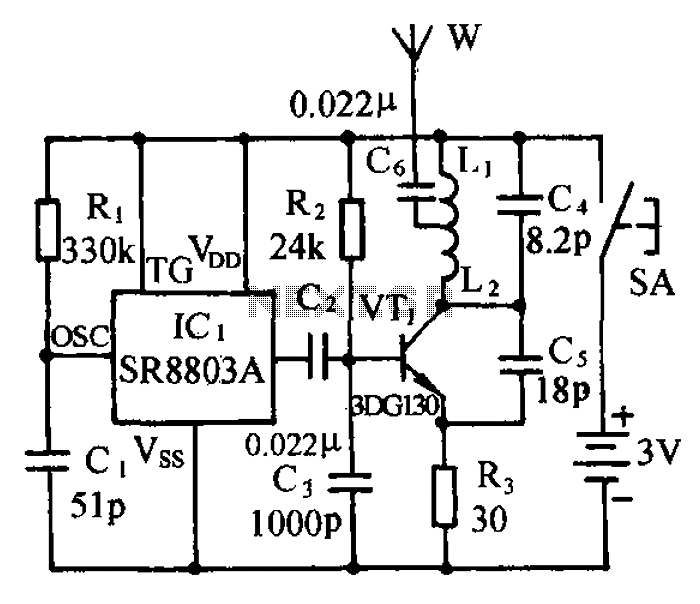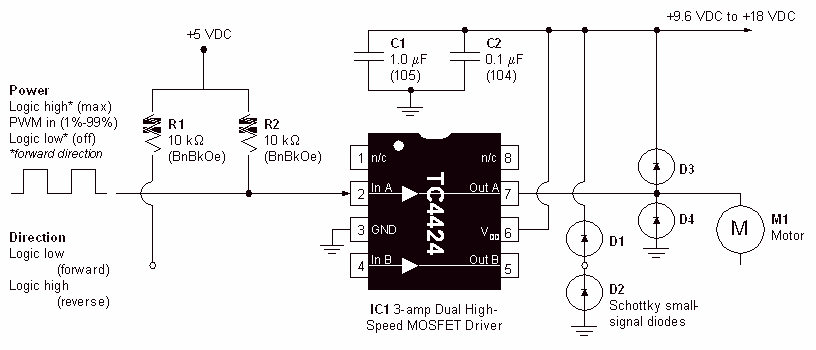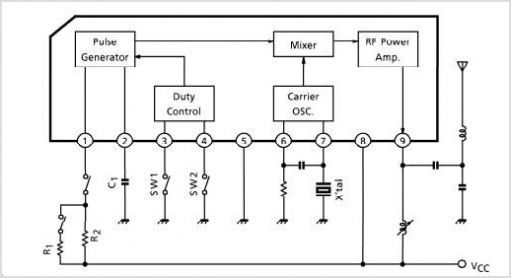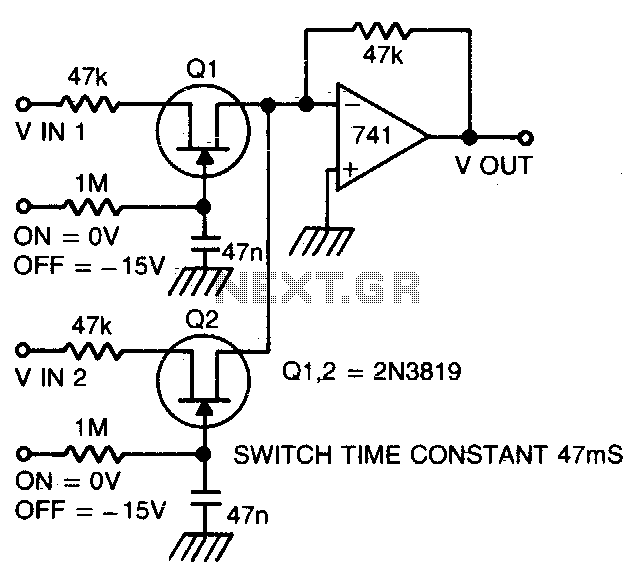
mic audio circuit
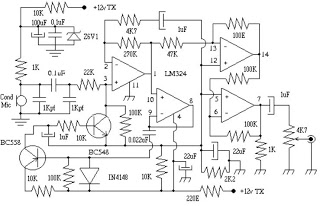
This circuit can be utilized in intercom systems, walkie-talkies, low-power transmitters, and packet radio receivers. Transistors T1 and T2 constitute the microphone preamplifier. Resistor R1 provides the necessary bias for the condenser microphone, while preset VR1 serves as a gain control for adjusting the amplification level. To enhance audio power, the low-level audio output from the preamplifier stage is coupled through coupling capacitor C7 to the audio power amplifier, which is based on the BEL1895 integrated circuit (IC). The BEL1895 is a monolithic audio power amplifier designed specifically for sensitive AM radio applications, delivering 1 watt into a 4-ohm load at a 6V power supply voltage. It features low distortion and noise and operates within a supply voltage range of 3V-9V, making it suitable for battery-powered applications. A turn-on pop reduction circuit is included to prevent audible thumps when the power supply is turned on. Coupling capacitor C7 influences the low-frequency response of the amplifier, while capacitor C9 functions as a ripple-rejection filter. Capacitor C13 couples the output available at pin 1 to the loudspeaker, and the R15-C13 combination acts as a damping circuit for output oscillations. Capacitor C12 provides bootstrapping functionality. This circuit is also appropriate for low-power HAM radio transmitters to supply necessary audio power for modulation and can be adapted for use in intercom systems with minor modifications.
This circuit design integrates various components to facilitate effective audio amplification and transmission. The combination of transistors T1 and T2 in the microphone preamplifier stage enhances the sensitivity of the microphone input, ensuring clear audio capture. Resistor R1 is crucial for establishing the correct operating point for the condenser microphone, allowing it to function optimally within the system.
The use of preset VR1 as a gain control allows for flexibility in audio levels, accommodating different environments and user preferences. The coupling capacitor C7 plays a dual role; it not only transmits the audio signal to the BEL1895 amplifier but also shapes the low-frequency response, ensuring that the audio output retains its integrity across a range of frequencies.
The BEL1895 IC is a key component, noted for its efficiency and performance in low-power applications. Its ability to deliver 1 watt into a 4-ohm load makes it suitable for driving small speakers or headphones directly, while its low distortion characteristics ensure high-quality audio output. The operational voltage range of 3V-9V enhances its versatility, allowing it to be powered by various battery configurations.
To mitigate power-on thumps, the inclusion of a turn-on pop reduction circuit is essential, enhancing user experience by preventing sudden loud noises when the device is activated. Capacitor C9, acting as a ripple-rejection filter, helps maintain a stable power supply to the amplifier, further improving audio quality by reducing unwanted noise artifacts.
The output coupling through capacitor C13 to the loudspeaker ensures that the audio signal is effectively transmitted, while the R15-C13 damping circuit stabilizes the output, preventing oscillations that could distort the sound. Capacitor C12's bootstrapping function enhances the amplifier's performance by improving its linearity and overall efficiency.
Overall, this circuit design is highly adaptable, making it suitable for a variety of applications, including intercom systems and low-power HAM radio transmitters, with the potential for further modifications to meet specific operational needs.It can be used as part of intercoms, walkie-talkies, low-power transmitters, and packet radio receivers. Transistors T1 and T2 form the mic preamplifier. Resistor R1 provi des the necessary bias for the condenser mic while preset VR1 functions as gain control for varying its gain. In order to increase the audio power, the low-level audio output from the preamplifier stage is coupled via coupling capacitor C7 to the audio power amplifier built around BEL1895 IC.
BEL1895 is a monolithic audio power amplifier IC designed specifically for sensitive AM radio applications that delivers 1 watt into 4 ohms at 6V power supply voltage. It exhibits low distortion and noise and operates over 3V-9V supply voltage, which makes it ideal for battery operation.
A turn-on pop reduction circuit prevents thud when the power supply is switched on. Coupling capacitor C7 determines low-frequency response of the amplifier. Capacitor C9 acts as the ripple-rejection filter. C13 couples the output available at pin 1 to the loudspeaker. R15-C13 combination acts as the damping circuit for output oscillations. Capacitor C12 provides the boot strapping function. This circuit is suitable for low-power HAM radio transmitters to supply the necessary audio power for modulation. With simple modifications it can also be used in intercom circuits. 🔗 External reference
This circuit design integrates various components to facilitate effective audio amplification and transmission. The combination of transistors T1 and T2 in the microphone preamplifier stage enhances the sensitivity of the microphone input, ensuring clear audio capture. Resistor R1 is crucial for establishing the correct operating point for the condenser microphone, allowing it to function optimally within the system.
The use of preset VR1 as a gain control allows for flexibility in audio levels, accommodating different environments and user preferences. The coupling capacitor C7 plays a dual role; it not only transmits the audio signal to the BEL1895 amplifier but also shapes the low-frequency response, ensuring that the audio output retains its integrity across a range of frequencies.
The BEL1895 IC is a key component, noted for its efficiency and performance in low-power applications. Its ability to deliver 1 watt into a 4-ohm load makes it suitable for driving small speakers or headphones directly, while its low distortion characteristics ensure high-quality audio output. The operational voltage range of 3V-9V enhances its versatility, allowing it to be powered by various battery configurations.
To mitigate power-on thumps, the inclusion of a turn-on pop reduction circuit is essential, enhancing user experience by preventing sudden loud noises when the device is activated. Capacitor C9, acting as a ripple-rejection filter, helps maintain a stable power supply to the amplifier, further improving audio quality by reducing unwanted noise artifacts.
The output coupling through capacitor C13 to the loudspeaker ensures that the audio signal is effectively transmitted, while the R15-C13 damping circuit stabilizes the output, preventing oscillations that could distort the sound. Capacitor C12's bootstrapping function enhances the amplifier's performance by improving its linearity and overall efficiency.
Overall, this circuit design is highly adaptable, making it suitable for a variety of applications, including intercom systems and low-power HAM radio transmitters, with the potential for further modifications to meet specific operational needs.It can be used as part of intercoms, walkie-talkies, low-power transmitters, and packet radio receivers. Transistors T1 and T2 form the mic preamplifier. Resistor R1 provi des the necessary bias for the condenser mic while preset VR1 functions as gain control for varying its gain. In order to increase the audio power, the low-level audio output from the preamplifier stage is coupled via coupling capacitor C7 to the audio power amplifier built around BEL1895 IC.
BEL1895 is a monolithic audio power amplifier IC designed specifically for sensitive AM radio applications that delivers 1 watt into 4 ohms at 6V power supply voltage. It exhibits low distortion and noise and operates over 3V-9V supply voltage, which makes it ideal for battery operation.
A turn-on pop reduction circuit prevents thud when the power supply is switched on. Coupling capacitor C7 determines low-frequency response of the amplifier. Capacitor C9 acts as the ripple-rejection filter. C13 couples the output available at pin 1 to the loudspeaker. R15-C13 combination acts as the damping circuit for output oscillations. Capacitor C12 provides the boot strapping function. This circuit is suitable for low-power HAM radio transmitters to supply the necessary audio power for modulation. With simple modifications it can also be used in intercom circuits. 🔗 External reference

